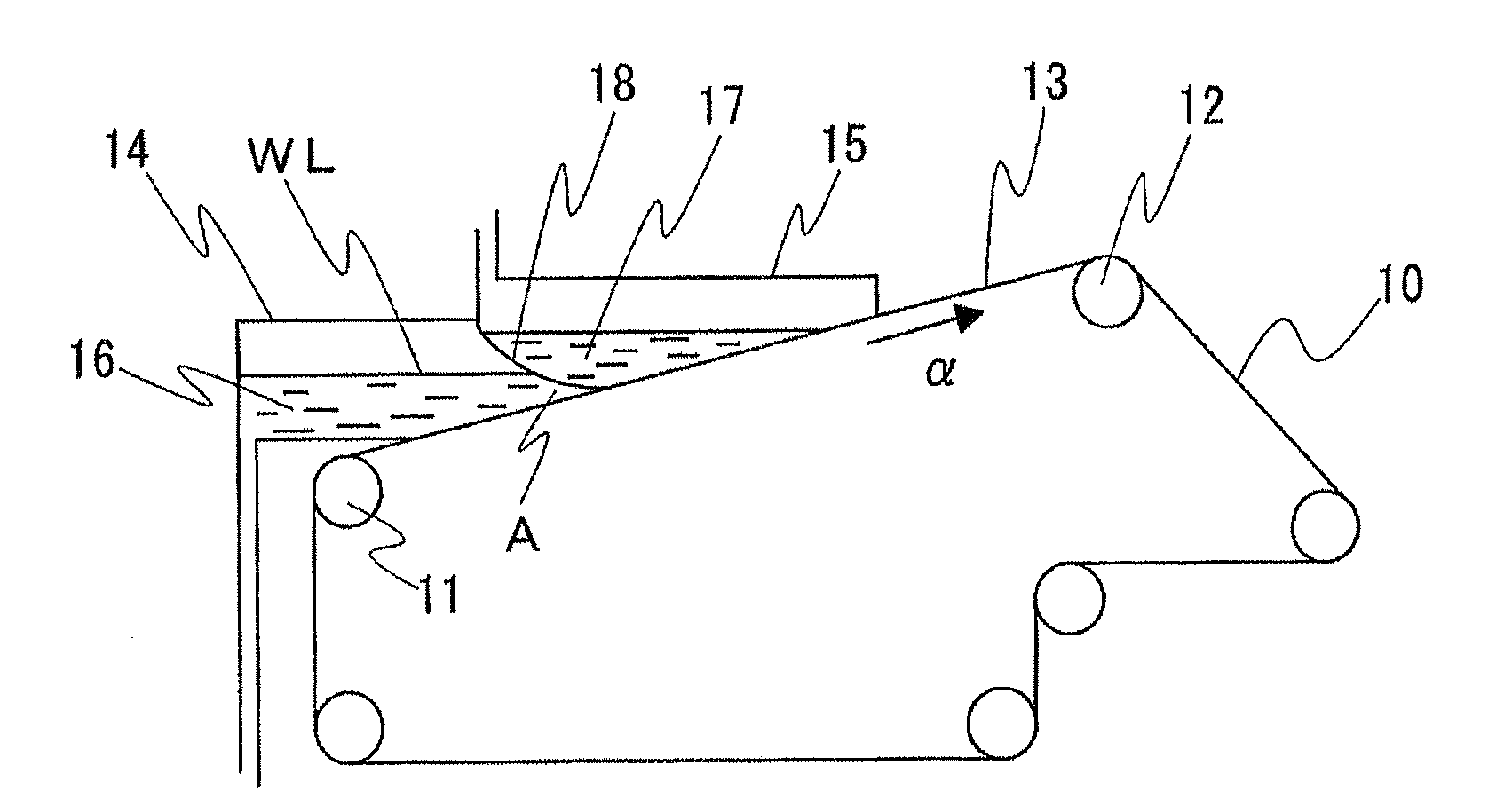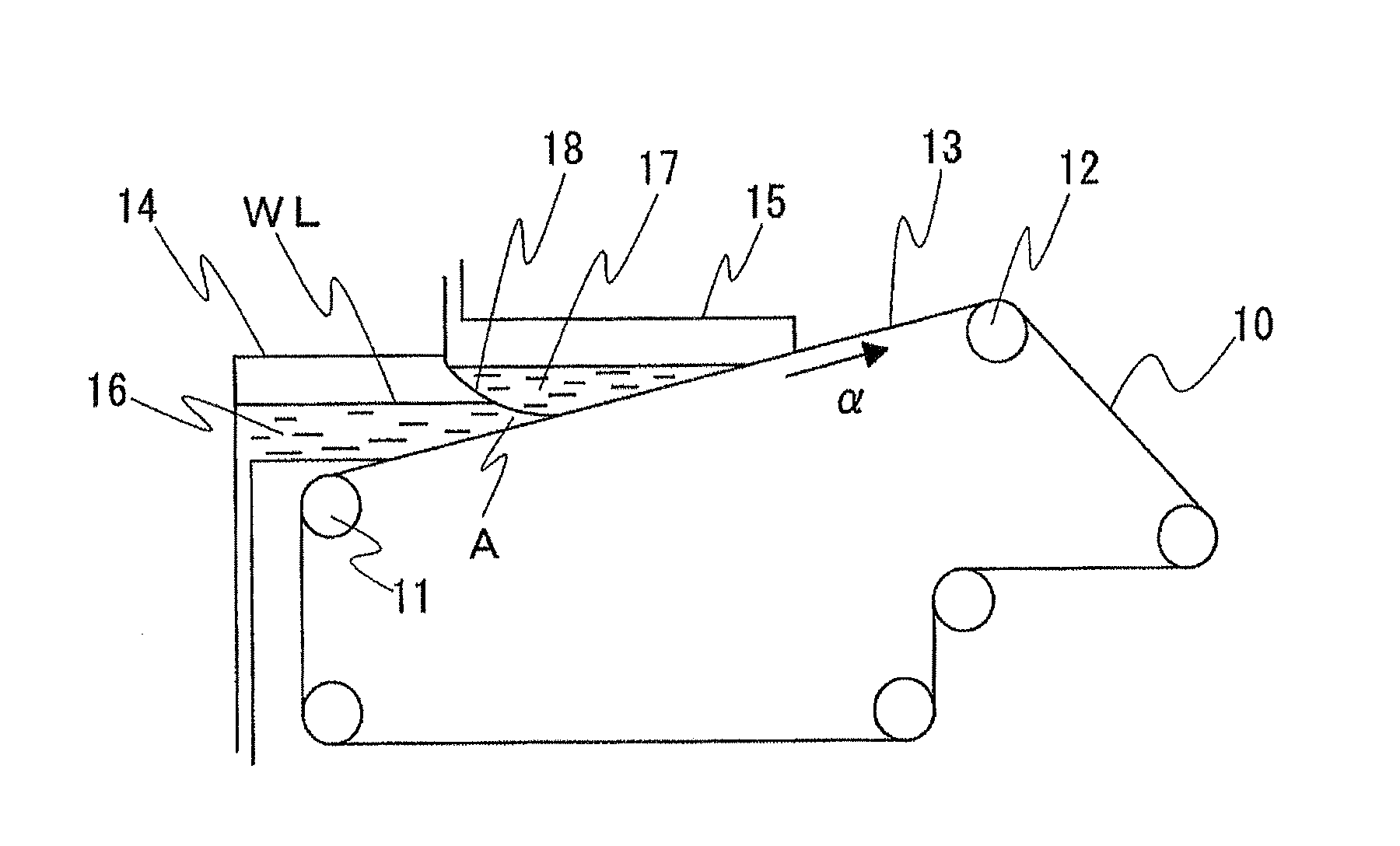Power storage device separator
- Summary
- Abstract
- Description
- Claims
- Application Information
AI Technical Summary
Benefits of technology
Problems solved by technology
Method used
Image
Examples
example 1
[0085]A fiber A comprising a polyethylene terephthalate fiber of 55% crystallinity having a fiber diameter of 2.5 μm and a fiber length of 6 mm, a fiber B comprising a wholly aromatic polyamide fibrillated to have a fiber diameter of 0.2 μm and a fiber length of 0.6 mm, and a fiber C comprising a solvent-spinned cellulose fibrillated to have a fiber diameter of 0.5 μm and a fiber length of 1 mm, at a mass ratio of 25:60:15, were respectively charged into ion-exchanged water to have a concentration of 0.05% by mass in a pulper. This mixture was dispersed for 30 minutes. By so doing, a paper material made of the fiber dispersion was produced.
[0086]The paper material was formed into a wet sheet by using a standard handsheet machine as defined in JIS P8222. Thereafter, the thus produced wet sheet was taken out from the handsheet machine and then dried at 130° C. by a Yankee type dryer, thereby producing a separator of the present invention. Regarding the physical properties of the produ...
example 2
[0087]A fiber A comprising a polyethylene terephthalate fiber of 73% crystallinity having a fiber diameter of 2.5 μm and a fiber length of 6 mm, a fiber B comprising a wholly aromatic polyamide fibrillated to have a fiber diameter of 0.2 μm and a fiber length of 0.6 mm, and a fiber C comprising a solvent-spinned cellulose fibrillated to have a fiber diameter of 0.5 μm and a fiber length of 1 mm, at a mass ratio of 25:60:15, were respectively charged into ion-exchanged water to have a concentration of 0.05% by mass in a pulper. This mixture was dispersed for 30 minutes. By so doing, a paper material made of the fiber dispersion was produced.
[0088]The paper material was formed into a wet sheet by using a standard handsheet machine as defined in JIS P8222. Thereafter, the thus produced wet sheet was taken out from the handsheet machine and then dried at 130° C. by a Yankee type dryer, thereby producing a separator of the present invention. Regarding the physical properties of the produ...
example 3
[0089]A fiber A comprising a polyethylene terephthalate fiber of 55% crystallinity having a fiber diameter of 3.2 μm and a fiber length of 6 mm, a fiber B comprising a wholly aromatic polyamide fibrillated to have a fiber diameter of 0.2 μm and a fiber length of 0.6 mm, and a fiber C comprising a solvent-spinned cellulose fibrillated to have a fiber diameter of 0.5 μm and a fiber length of 1 mm, at a mass ratio of 40:40:20, were respectively charged into ion-exchanged water to have a concentration of 0.05% by mass in a pulper. This mixture was dispersed for 30 minutes. By so doing, a paper material made of the fiber dispersion was produced. Thereafter, a separator of the present invention was produced in the same manner as that of Example 1. Regarding the physical properties of the produced separator, the film thickness of the separator was 49 μm, the density was 0.32 g / cm3, and the air permeability was 15 seconds / 100 ml.
PUM
| Property | Measurement | Unit |
|---|---|---|
| Fraction | aaaaa | aaaaa |
| Percent by mass | aaaaa | aaaaa |
| Percent by mass | aaaaa | aaaaa |
Abstract
Description
Claims
Application Information
 Login to View More
Login to View More - R&D
- Intellectual Property
- Life Sciences
- Materials
- Tech Scout
- Unparalleled Data Quality
- Higher Quality Content
- 60% Fewer Hallucinations
Browse by: Latest US Patents, China's latest patents, Technical Efficacy Thesaurus, Application Domain, Technology Topic, Popular Technical Reports.
© 2025 PatSnap. All rights reserved.Legal|Privacy policy|Modern Slavery Act Transparency Statement|Sitemap|About US| Contact US: help@patsnap.com


